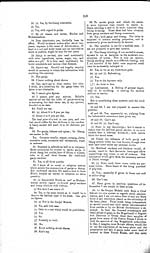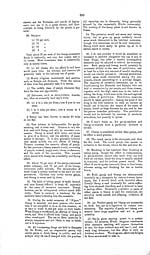Medicine - Drugs > Report of the Indian Hemp Drugs Commission, 1894-1895 > Volume IV
(263) Volume 4, Page 249
Thumbnail gallery: Grid view | List view

249
existing circumstances is
for political reasons not
possible.
I am not thoroughly
acquainted with the excise
system in the Regulation Districts, but there the
cultivation of the hemp is, I believe, interdicted,
while arrangements exist for allowing confirmed
ganja-smokers and bhang-consumers to obtain their
favourite drugs from licensed sellers. I would
restrict the wholesale as well as retail sale of
ganja as much as possible, leaving the district
officer to decide what the safe limit is.
64. No ganja is imported
into the Gurjat
States from the Mogalbandi Districts, but both
hemp and ganja are freely exported under passes
granted by the Regulation District officers from
these Native States. Were I a native chief. I
should raise the export duty on these consignments
to the highest payable limit. At present, and to
my knowledge, none of the chiefs collect any such
export duty, and ganja is therefore much cheaper
than it should be. I have no
objections to the
existing Mogalbandi regulations.
65. Not
knowing what the rates of taxation in
the Mogalbandi are, I can
give no opinion.
66. I see no
reason to suggest differential rates
of taxation.
67. See answer to 65.
68. None to my
knowledge in the States under
the administration of these chiefs.
69. See above.
70. In the case of
a plant or drug so easily
reared and prepared, practically without restriction
in Native States in Orissa, there must be con-
stant smuggling, on a small scale, into the
adjoining Regulation Districts. The actual harm
done is, however, so infinitesimal, and to such a
very small proportion of the Orissa population,
that any more stringent measures than now exist
appear to me uncalled for and unnecessary.
92. Evidence of
Mr. W. R. RICKETTS,* Manager, Nilgiri State,
Tributary
Mahals,
Orissa.
1. As a
member of the Provincial service, I have
had charge of the Excise Department both at the
Sudder Station and Sub-Division, and for the last
nine and a half years 1 have had entire charge as
Manager of the Excise Administration in the
Native State of Nilgiri, one of the Tributary
States in the province of Orissa.
2 The definitions are
correct as regards siddhi
or bhang or ganja (round, flat and broken).
Bhang is commonly known in this province by
the name of "patti." Charas is not used in
Orissa, except by visitors from the north of India
and Behar.
3. In north of
Balasore and in the Native States
of Maurbhanj and Keonjhar, the hemp plant grows
spontaneously, but not in very large quantities.
In Nilgiri very few cultivate the plant in their
kitchen gardens, but only use it as patti. No
ganja is cultivated.
4. It is only
known as ganja here. I don't
know of any other name being applied to the
plant.
5. It
requires damp, loose soil, and mostly
grows spontaneously near the sea and close to
rivers.
6. Where it grows, it is dense.
7. In North
Balasore, Maurbhanj and Keonjhar
it is cultivated only for bhang The little ganja
is of a very poor quality. Proportionately speak-
ing, it is grown in a small quantity. The fibre is
not used, nor does any exist. Some few keep seeds
for cultivation.
8. There has
been a decided decrease in the
area under cultivation, mainly due to the article
which can be purchased being much superior and
consequently preferred by consumers.
10. They belong to all classes in this province.
11. Wild hemp
as a rule won't produce ganja;
when it does, the quality is very inferior.
12. I don't know of any such district.
13. Ganja cultivation is
restricted in Orissa in
all districts, but not in the Tributary States. In
the latter, a very small quantity is cultivated, but,
as I have said before, of a very inferior quality.
The cultivation of ganja requires very heavy dew,
which does not fall here. It
would be impossible
to cultivate good ganja in Orissa.
14. Inferior ganja and
bhang, both in small
quantities. Ganja is prepared only in the Tri-
butary States; bhang in the Tributary States and
in the district of Balasore. No charas is prepared
in this province.
16. Bhang is
usually prepared in this province
by the people in their own houses from the wild
hemp wherever it grows spontaneously. Ganja
can be prepared from the wild plant, but the qua-
lity is inferior.
17. In Orissa
and the Tributary States bhang
and inferior ganja to a small extent are prepared
by all classes
18. Both
ganja and bhang deteriorate by keep-
ing. After about eighteen months they quite lose
their effect; they keep good with ordinary care for
about a year. The resinous substance evaporates,
The measure usually taken to preserve ganja and
bhang is to exclude it as much as possible from the
air.
19. In Orissa and
the Tributary States ganja is
mostly used for smoking mixed with prepared
tobacco; it is also to a small extent eaten with pan
and drunk. For drinking purposes it is mixed with
a concoction prepared with water, black pepper, and
hot spices, to which sometimes sugar is added to
make it stronger, Ganja is drunk principally in
the Puri District, but it is smoked all over the
province.
20. Both the high and low
classes of people in
Orissa smoke ganja, but I should say a small
number in proportion to the population.
21. Round ganja is always
preferred here for
smoking, and is usually used for this purpose in
all parts of the province and the Gurjat States.
23. Bhang is not used for
smoking in Orissa or
the Native States here.
24. All classes in all
localities in Orissa and the
Native States drink and eat bhang, but by far the
larger number of consumers drink it, as I have
already described.
25. I should say the use
of ganja and bhang is
decidedly on the increase. The drugs are becoming
more popular, as they are within the means of all
* Was summoned to attend at a meeting of the Commission for oral examination, but was unable to appear.
2 M
Set display mode to: Large image | Zoom image | Transcription
Images and transcriptions on this page, including medium image downloads, may be used under the Creative Commons Attribution 4.0 International Licence unless otherwise stated. ![]()
| India Papers > Medicine - Drugs > Report of the Indian Hemp Drugs Commission, 1894-1895 > Volume IV > (263) Volume 4, Page 249 |
|---|
| Permanent URL | https://digital.nls.uk/74552776 |
|---|---|
| Description | Evidence of Bengal witnesses. |
| Description | Volume 4: Evidence of witnesses from Bengal and Assam. |
|---|---|
| Attribution and copyright: |
|




